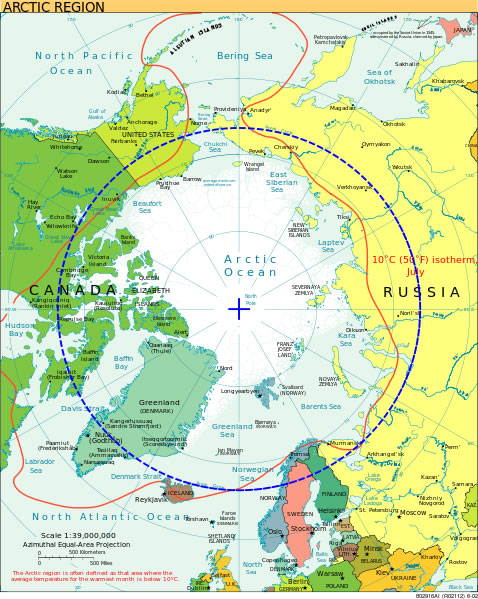 Map of the Arctic with the Arctic Circle in blue. |
|||
An
Izvestia source has declined to comment on an exact deadline for the system
to meet and on the place of its future deployment, citing the confidential
nature of the matter. He explained to the Izvestia, however, that, once
deployed, the hydroacoustic system would cover an area measuring hundreds
of square kilometers. The prime contractor for the system is Almaz-Antei Corp.’s recent subsidiary Kometa Corp., a specialist in special space systems, leading several dozen subcontractors under this program. Three legs of the three-pronged system have to be developed. The maritime leg of the triad will be in the form of sonobuoys and underwater sensors gathering data and transmitting it to the satellites of the space-based leg. The ground leg is the control system designed to analyze the data and distribute it among subscribers. As far back as the mid-1960s, the US Navy started deploying the SOSUS (Sound Surveillance System) global hydroacoustic system designed to track Soviet - now Russian - submarines in the first place. Set up at depth of several dozen meters, the SOSUS sensors constitute several lines along the Greenland - Iceland - UK route, with individual posts installed in the Pacific as well. The SOSUS remains operational now. According to an engineer involved in the development, a most difficult problem encountered by the Russian sonar system’s designers is to develop sonobuoys and underwater sensors that are both effective and self-contained enough. The sonars equipping the sonobuoys and sensors have to be small enough, on the one hand, and have to detect acoustic signals at long range, on the other. One also should keep in mind the problem of power supply, because satcom systems equip the sonobuoys and sensors too. According to expert Dmitry Boltenkov, the most probable place for the cutting-edge sonar system to be deployed is the Arctic. US and UK nuclear submarines operated aggressively specifically in the Arctic as far back as the Cold War, entering Russia’s northern seas in particular. Even now, they try proactively to shadow the Northern Fleet’s surface ships and submarines all the more so that the Russian Navy has received the advanced Project 885 Yasen-class (NATO reporting name: Severodvinsk-class) nuclear-powered attack and Project 955 Borei-class (Dolgorukiy-class) nuclear-powered ballistic missile submarines. In addition, the probable enemy’s boats carry Tomahawk sea-launched cruise missiles with a reach of more than 1,500 km. In particular, Northern Fleet ships detected a US Virginia-class nuclear-powered attack submarine in the Barents Sea in August 2014. Following a 27-minute-long chase by surface ships and Ilyushin Il-38 (May) antisubmarine warfare planes, the US Navy’s boat left the area, according to the Izvestia daily. © Copyright 2016 TASS. All rights reserved. This material may not be published, broadcast, rewritten or redistributed. |
|||
Russia Developing SOSUS-Type Sonar System to Protect Territorial Waters in the Arctic
- Posted On










